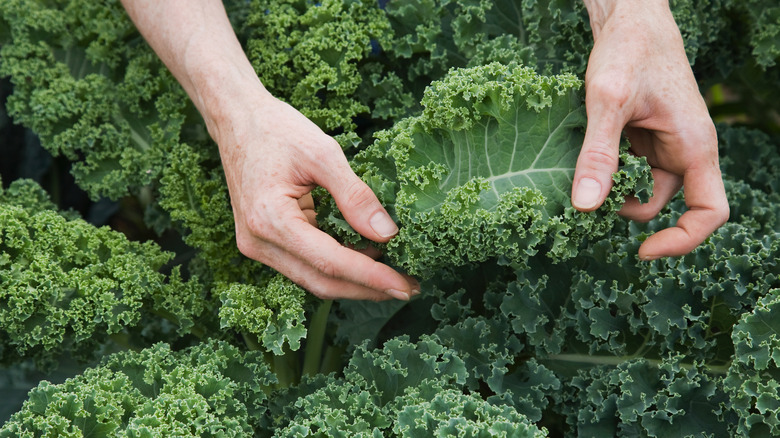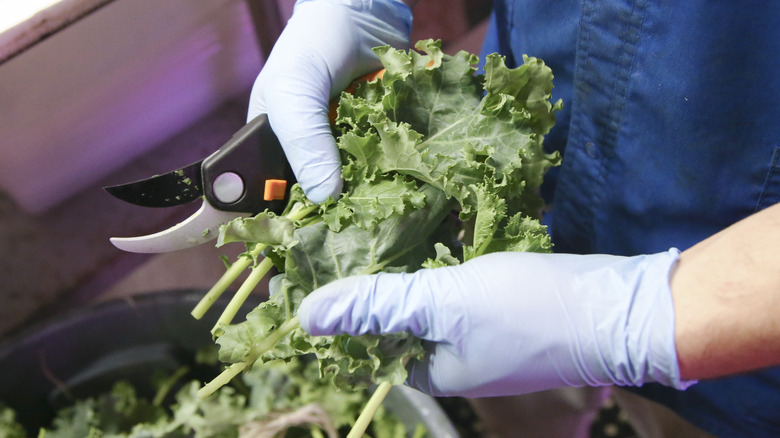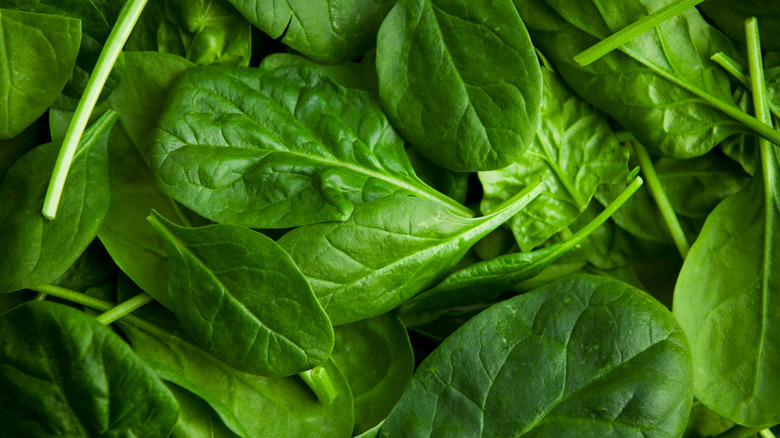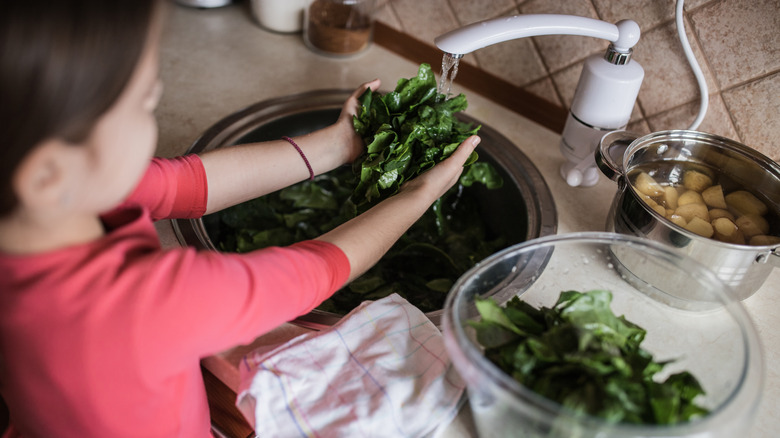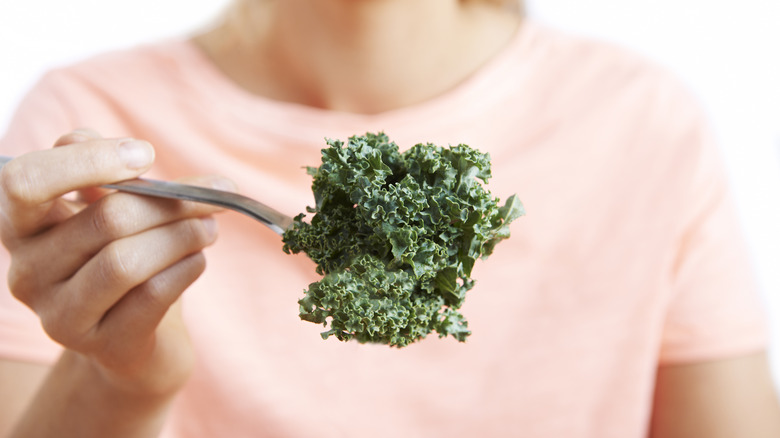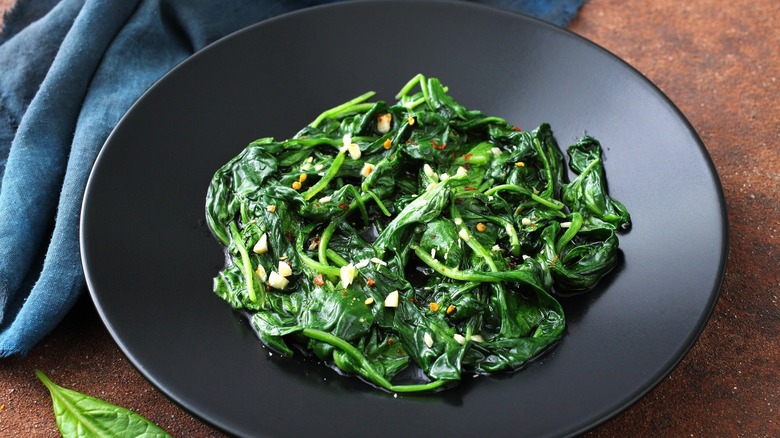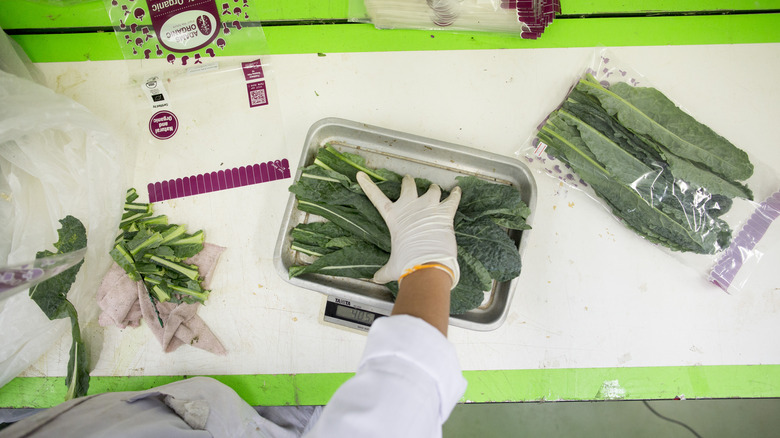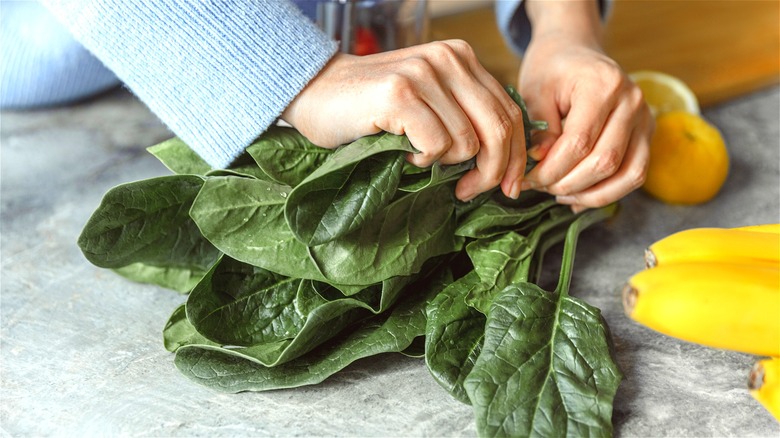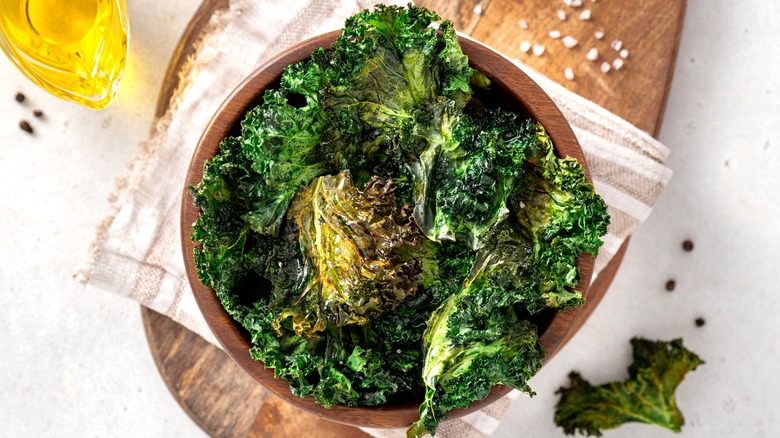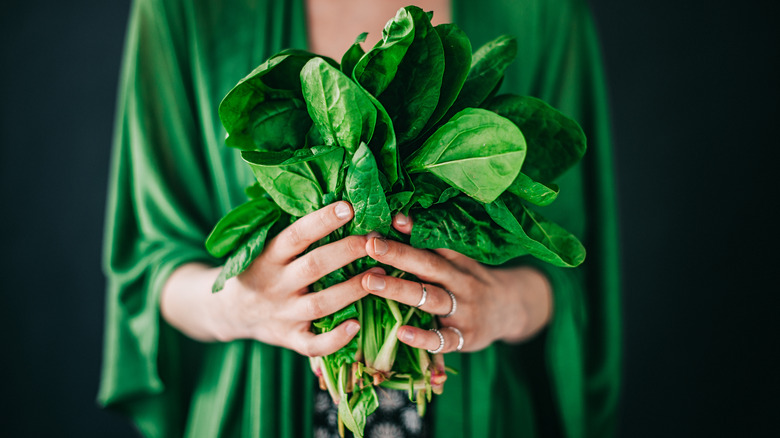Kale Vs Spinach: Everything You Need To Know
Dark, leafy green vegetables are rightfully celebrated as one of the healthiest food groups around, thanks to the high levels of nutrients they contain. Eaten in the Americas since at least the 17th century, these vegetables reached a new level of notoriety during the so-called kale craze of the early 2010s. Spurred on by celebrity endorsements from the likes of Gwyneth Paltrow, the health-giving properties of dark, leafy greens propelled the food group to national acclaim.
These days, several leafy green vegetables can be found in America's grocery stores. Kale and spinach are two of the most prevalent. Unfortunately, the media attention that leafy greens — especially kale — garnered in the previous decade has not translated into Americans having a thorough understanding of them. This leads many people to overlook the fact that, while kale and spinach share a great number of characteristics, each has unique properties and nutritional profiles, making them suited to different culinary applications. In the following article, we help fix that, by highlighting everything you need to know about these two distinct leafy greens.
What is kale?
Kale (Brassica oleracea, variety acephala) is a type of edible plant that belongs to the cruciferous family, making it closely related to cabbage, brussels sprouts, and broccoli. The defining feature of kale is its large, edible leaves. These come in an array of shapes and colors including green and purple. Regardless of color, each leaf has a thick, strong stem running down the middle of it. The stems pose a challenge to cooks who often discard them. However, with proper preparation, kale stems can be enjoyed alongside the leaves.
California is the largest producer of kale in the United States, although the vegetable is grown across the country. Best harvested during fall and early winter, kale nonetheless features on the shelves of American grocery stores all year round. This was not always the case. During the 20th century, kale was predominantly seen as a decorative plant and was rarely stocked by the nation's major grocery store brands. That has since changed, with kale now being stocked everywhere from your local farmers market to Walmart.
What is spinach?
Spinach (Spinacia oleracea) is a dark, leafy green vegetable belonging to the Amaranth family. Spinach has been popular in the U.S. since the 19th century and was further promoted by the government during the early 20th century. It is currently sold in three forms: canned, frozen, and fresh. Of these, fresh is the most popular, accounting for approximately 75% of all spinach consumed in the U.S.
Spinach is thought to have originated in southwest Asia. From there, it spread to Europe, before being introduced to America by colonists. The plant produces green, edible leaves that are often picked early and sold under the moniker baby spinach.
Baby spinach can be eaten raw, thanks to its tender texture and mild flavor. The stem of these leaves is also tender and does not require any preparation to become palatable. Larger, more mature spinach leaves are also regularly eaten, however, these usually require more preparation and cooking time.
Spinach is easier to prepare
As dark, leafy greens go, kale has a tough texture. To make the leaves more tender, many cooks and food writers urge others to perform a technique known as "massaging" to the kale. This tenderizing process involves coating the kale leaves with a sprinkling of salt and lemon juice or oil (or both) before rubbing them until they begin to wilt. After massaging, the kale leaves are noticeably more tender.
Unfortunately, massaging results in kale forming a compound that can sometimes make it taste more bitter — unless the kale is washed afterward. What's more, massaging will not tenderize kale's tough stems. These must either be discarded or finely chopped and cooked before enjoying. Even if massaging is performed, some kale is subsequently cooked to ensure it is tender enough to be palatable. All these steps make kale a time-consuming vegetable to prepare.
Spinach, as a tender, mild-tasting dark, leafy green, can be enjoyed with almost no preparation. This is especially true for baby spinach, which only needs to be washed before being eaten. As a result, it makes a fantastic ingredient for salads. That being said, some types of spinach, especially those that are more mature, do taste better when their stems are removed and cooked before consumption. However, spinach is generally a much easier and quicker vegetable to prepare than kale.
Kale has a stronger taste
Several people opt to massage kale, ensuring it is tender enough to enjoy raw. As mentioned, this action breaks down the plant's cell walls, creating a bitter-tasting compound. This bitterness can be minimized by cooking the kale or rinsing it after it has been massaged or chopped. However, these processes do not eliminate all of the plant's bitterness.
Kale's pronounced bitter flavor affects how it is used in the kitchen, as Chloe Schweinshaut, a registered dietician, told Boston Magazine: "Raw kale has a more bitter taste as compared with spinach and it tends to take center stage in anything you put it in. I prefer to use spinach in the recipes I really want to get the benefits of eating the green but don't want to overpower the flavor of the dish."
Spinach's mild flavor makes it a much more versatile vegetable. Aside from being used in salads, spinach's mild flavor makes adding it to a smoothie an easy way to boost a smoothie's nutritional profile without impacting the beverage's overall flavor. Spinach's lack of flavor also means that, when sauteed, it can be used as an accompaniment to many different types of meat or fish. All cooks have to do is add various herbs, spices, and other ingredients to build a flavor profile that perfectly compliments the rest of their dishes.
When it comes to cooking, spinach performs worse
Kale's bitterness and tough texture make it an unsuitable addition to some dishes, including smoothies. That being said, the robust nature of the leaves means that it can stand up to many cooking processes including boiling, stir-frying, and roasting. It was this last technique that catapulted kale to fame in 2011 when Gwyneth Paltrow made kale chips on "The Ellen DeGeneres Show."
Spinach, especially spinach leaves that are harvested young, don't display a similar structural integrity. By many accounts, baby spinach should not be cooked at all. This is because it breaks down incredibly easily when exposed to heat, quickly adopting an unpleasant, slimy texture. Mature spinach is more suited to cooking as it has a tougher texture. This allows the leaves to be sautéed, blanched, or steamed without losing all of their bite. However, spinach of any age does not boast the structural integrity of kale and is ill-suited to being exposed to high temperatures for prolonged periods.
More types of kale are readily available
There are approximately 150 known varieties of kale in the world. Of these, only a handful are sold in grocery stores, and curly kale is the one you're most likely to come across in-store. Curly kale demonstrates the characteristics many of us associate with the vegetable, including a bitter taste and tough texture, but it's by no means the only variety. Other readily available varieties include Tuscan kale, which has darker, flatter leaves. With a slightly sweet flavor, this type of kale is better suited to raw consumption than curly kale. Despite this, Tuscan kale remains a common feature in many Italian soups and stews such as ribollita. Other kale varieties that are readily available include baby kale, red Russian kale, and redbor kale.
In comparison, very few of the many known spinach varieties are available in American grocery stores. The vast majority of stores make do with only stocking flat-leaf spinach, the variety that is harvested young and sold as baby spinach. Aside from being simple for consumers to prepare and enjoy, flat-leaf spinach is also one of the easiest varieties for producers to prepare, as its smooth leaves make for simple and effective washing.
Other types of spinach can be found for sale in the U.S. at farmer's markets. These include savoy spinach, a larger, tougher variety that has curled leaves. Attempts to develop new and interesting varieties have resulted in the release of new varieties.
In some ways, spinach is less healthy
Both spinach and kale have a reputation for being incredibly healthy foods. This reputation is warranted. According to the U.S. Department of Agriculture, spinach contains impressive amounts of many nutrients, including vitamin K. Kale does as well, per the USDA. There are, however, a few instances where the nutritional profiles of kale and spinach diverge. For example, kale contains three times more vitamin C than spinach and nearly twice as much fiber. For some people, this makes kale the healthier choice. That being said, spinach does have the edge in some areas. Most notably, it contains more iron, folate, and vitamin A.
While many people get caught up trying to discern whether kale or spinach is healthier, nutritionists urge consumers to eat both. This is because, aside from providing ample nutrition, a diet rich in these vegetables can help protect people from developing certain diseases, as Chloe Schweinshaut explained to Boston Magazine: "Both are highly nutritious choices overall though, as they are a great source of antioxidants, which are substances that can protect your cells from free radicals causing diseases like cancer."
Even when cooked, kale can cause bloating
As a cruciferous vegetable, kale contains a sugar called raffinose, according to Time. As IOPscience explains, humans do not produce the enzyme required to break down raffinose, meaning that it reaches our gut microbiome intact. Here, bacteria break the raffinose down and ferment it. This results in the production of hydrogen and carbon dioxide gasses which, in turn, cause flatulence and bloating, per a 2007 study published in the journal Digestive Diseases and Sciences.
Kale's high fiber content can also contribute to bloating if those eating it do not usually partake in a fiber-rich diet. To give their bodies time to adjust, those new to kale are encouraged to steadily introduce it into their diets (via Gas-X).
As another vegetable rich in fiber, spinach can also cause bloating if suddenly introduced in large quantities. However, spinach does not contain raffinose, meaning bloating may be more easily avoided than with kale. Finely chopping and cooking the spinach will also help reduce bloating.
Kale is more of a recent trend than spinach
In the U.S., spinach has long been a popular food item, having been consumed in the country for hundreds of years. President Roosevelt's 1936 Soil Conservation Act made it even more popular, as it promoted spinach as a non-soil-eroding crop. During this time, spinach was also being touted as an incredibly healthy food by none other than Popeye, the popular cartoon character. The effects of these promotions are still being felt. In the 21st century, spinach has retained a large and robust consumer base in the U.S., with the average American consuming around 2 pounds of spinach in 2022, according to Statista.
Although kale has long been popular in countries such as Scotland, the dark, leafy green only rose to prominence in the U.S. more recently, during the 21st century. Celebrity endorsements from the likes of Gwyneth Paltrow and Beyoncé helped matters, however, the person behind kale's rise was not a celebrity. A woman named Oberon Sinclair, owner of an American public relations firm, kick-started kale's rise to fame by encouraging one of her clients, a New York restaurant called The Fat Radish, to put it on the menu. Sinclair then pushed kale via an online campaign. Speaking to Entrepreneur about the ensuing kale craze, Sinclair said: "It's ridiculous what's gone on. I felt I had imposter syndrome. I still do. I'm still like, 'Who did that? Oh, I did.'"
Spinach can contribute to kidney stone formation
While kale is notorious for causing bloating, eating lots of spinach does have its drawbacks. Chief amongst these is potentially contributing to the formation of kidney stones. Spinach has been linked with the formation of kidney stones because it is high in oxalates, which, when ingested, bind to calcium, reports Colorado State University. If they aren't passed during urination, these compounds can accumulate to form kidney stones. As a result, it is advised for people who are trying to minimize the risk of developing kidney stones to limit their intake of spinach and any other oxalate-rich food, according to the National Kidney Foundation.
Kale, on the other hand, contains a low concentration of oxalates. Even when eaten in vast amounts, the risk of it causing kidney stones is negligible, as University of Chicago kidney specialist Dr. Fredric Coe highlighted to Medill Reports Chicago: "Kale offers all the benefits of dark green vegetable but it ranks low in oxalate. There's only 17 milligrams of oxalate in a hundred grams (about 3 ounces) of kale ... Essentially, it's about impossible to eat enough of kale to cause kidney stones."
